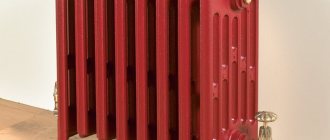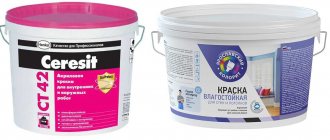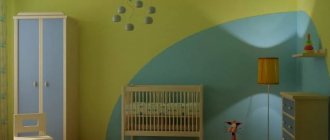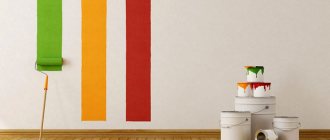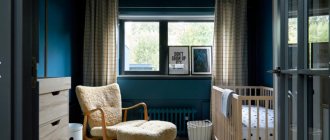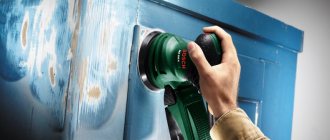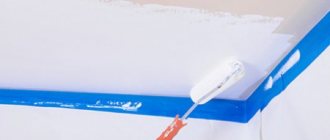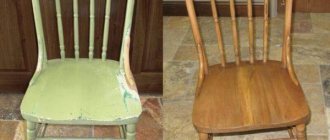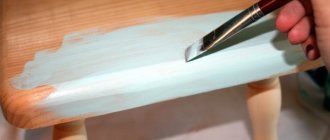At least once every five years a person faces a repair issue. Many people find themselves choosing which paint is best to purchase to update their interior. It is necessary to find out the difference between water-based paint and water-dispersion paint, analyze the technical characteristics of each type (composition, specific gravity, advantages, disadvantages, etc.), and make a decision taking into account its inherent features.
Properties
It is easier to determine the difference between water-dispersion and water-based paints once you know the criteria and product characteristics. They have both similar and different characteristics:
- main, auxiliary components;
- specific gravity of the coating, load;
- viscosity, solvents, temperature dependence;
- consumption of coloring solution per square meter of area;
- features of application, choice of method;
- shelf life during which the original indicators are retained.
Advantages and disadvantages
We looked at what dispersion paint is. Now let's highlight its advantages and disadvantages. The first thing worth noting is that the product is safe and environmentally friendly due to the use of water as a solvent. The paint does not have an unpleasant odor, it does not burn, and mold and mildew do not form on the painted surface - this means that the paint breathes.
The lifespan of the dye is about 15 years. In this case, the material will not swell or crack. It takes about two hours for the layer to dry completely. Also among the advantages is the affordable price.
There are also disadvantages - the quality of the treated surface depends on the weather. Do not paint during precipitation or low temperatures. During precipitation, the water will not evaporate. Painting at high temperatures is also not recommended. Before starting work, you need to prepare the surface - you need it to be level. A thin layer of paint will not be able to hide unevenness. Another disadvantage is that the price may be higher than those products that use other solvents.
Water-based paints
The basis of this variety is water, which dilutes all kinds of thickeners, pigments, and polymer compounds. The whitening component is zinc oxide, styrene acrylate forms a protective film. The purpose and characteristics of the product depend on the percentage of components. Viscosity is changed by the amount of solvent.
Improving the versatility of the finished product, manufacturers add resins:
- mineral;
- acrylic;
- silicone.
The specific gravity of the protective coating formed is 1.4-1.5 kg, the consumption of such products is 210 ml per 1 sq. meter. This indicator is variable, changing from the following data:
- type of surface to be painted;
- amount of added solvent;
- how much the base absorbs;
- other.
Advantages:
- environmental safety, no odor, no harmful fumes;
- ease of use, choice of any known method;
- color change is carried out by adding pigment;
- availability, low consumption.
There are several types, differing in composition, scope of application, characteristics, properties:
- silicate;
- acrylic;
- mineral;
- silicone.
The acrylic variety is universal; it paints glass, metal, brick, concrete, wood and surfaces made from them equally well. Silicone and mineral solutions are of good quality, but expensive; silicate types are used in rooms with high humidity.
Features of acrylic compositions
The main components of this group are acrylic composite and water. During the drying process, not only moisture evaporates, but also polymerization of the components occurs, resulting in the formation of a highly durable coating.
Acrylic is suitable for working with glass, metal, wood, canvas, linen and other materials that have a non-greasy base. Fresh stains of this type of paint can be easily washed off with plain water. However, if the stain has already dried, you have to resort to using a solvent.
Advantages of acrylic paints.
- The products are non-toxic and considered environmentally friendly. They are practically odorless and do not contain harmful substances.
- A wide color palette allows you to choose an option for every taste. In addition, you can prepare the shade you need in a special machine.
- Acrylic paints are resistant to ultraviolet radiation, high humidity and temperature changes. They can be used for finishing both indoors and outdoors. Also, this group of paints and varnishes has a vapor-permeable coating layer, which eliminates the accumulation of moisture in the walls.
- Acrylic coating is durable (it remains in excellent condition twice as long as oil coating).
- The layers dry very quickly. There are brands whose compositions dry in 1 hour.
- The quality and aesthetics of the appearance of the painted surface will satisfy the most demanding customers. After drying, the layers do not crack.
- The paints are frost-resistant (freeze at temperatures below – 40°). However, it should be remembered that thawing should be gradual, even if it takes several days. This process cannot be accelerated with the help of heating devices, hot water, etc. After the paint has thawed, it is necessary to check whether thickened particles have appeared in it or whether it has delaminated. Then you should thoroughly stir the composition and dilute it with water, if necessary.
Water-dispersed
An aqueous dispersion that dissolves acrylic, polyvinyl acetate and latex components. You can find out what water-dispersion paint is by determining its characteristics. The components dissolved in PVA form a mixture that is inexpensive and wear-resistant. It is used for painting floor coverings, but quickly gets dirty and allows moisture to pass through.
Based on latex, it is stronger than water-based, more stable, has dirt- and water-repellent properties, and the acrylic solution of components is used for exterior decoration of buildings and is well resistant to atmospheric phenomena. The protective surface perfectly withstands repeated cleaning, washing, and treatment with products.
Popular products
There are several types of VDAK paints, each of which has its own unique properties and purpose. General description of the most popular products:
- Paint VD AK-1180. Used as a base for initial and secondary coatings. Weather-resistant, moisture-resistant, covers a wide color spectrum. VD AK-1180 paint is popular in the construction of large industrial facilities.
- Paint VD AK-111. Thanks to its unique composition with a latex base, the paint becomes more resistant to mechanical stress and natural factors.
- Paint VD AK-101. The material is suitable for painting surfaces of any type. This paint dries quickly and is completely environmentally friendly, which allows it to be used for interior work.
The most popular paint for exterior work is VGT VD AK-1180 enamel. The material is intended for painting concrete, wooden and plastered walls; it has high water and weather resistance. VGT 1180 facade paint is excellent value for money.
Water-dispersion paints VD AK of other types are used less often or have a narrow profile with limited application properties, for example, painting floors, painting wooden structures, etc. Below we will consider in more detail the technical characteristics of the different options.
On video: features of water-based paints.
Advantages of water-based solutions
It is recommended to paint surfaces at temperatures above 5 degrees. The protective layer dries quickly enough; re-application of the mixture can begin after 2 hours. They do not require careful surface preparation - they fill small gaps and cracks well.
Advantages inherent in the varieties:
- form a breathable surface;
- durable, retain their original properties for a long time;
- resistance to temperature changes;
- aggressive cleaning agents do not cause harm;
- absence of harmful components, odor;
- compatible with any surfaces except metal.
Conclusion
Despite the fact that most of the composition of the presented paints is made up of ordinary water, they can differ significantly in cost. In addition, materials differ in their hiding power.
It should also be said that dispersed paints are resistant to water, while emulsion paints are easy to wash off from the surface. The materials also differ in the solvent used. To control the density of dispersed compositions, water is used, and emulsion compositions use white spirit. In addition, the first option is produced exclusively in white, while the second can be multi-colored or tinted.
Difference
The difference between water-based and water-dispersion paint is invisible to the naked eye. The first variety covers surfaces better due to its good viscosity, and consumes less because it is not absorbed. The second mixture is stronger, wear-resistant, and durable.
The increased moisture resistance of dispersion products significantly expands the scope of use, while emulsion products are easily washed off with water, which makes them unsuitable for exterior decoration, treatment of bathrooms, baths, saunas.
Water-based paints also differ from water-dispersion paints in their use of solvents. The first type of mixture is recommended to be diluted with weak, medium-strength solvents; for the second type, ordinary water is sufficient. Although they have similar names, they still differ from each other.
The mixtures have many similar characteristics, but differ in properties, prices, and solvents. They are not interchangeable solutions; they are used in different areas, which are dictated by increased or decreased moisture resistance. When choosing the right solution, they rely on the type of base being treated.
What to look for when choosing
When choosing paint for the ceiling, it is recommended to adhere to the following criteria:
- When choosing the color and texture of the material for painting the ceiling, you need to take the interior style of the room, its purpose and the dominant color shades as a guide. Ceiling paint can be matte, semi-gloss or glossy. The latter option helps to achieve a visual expansion of space. Matte white paint imparts a discreet nobility and balance to the home.
- Preparing the base for painting is labor-intensive, because... the finished surface must be perfectly flat. It will require laying several layers of putty and sanding. It is impossible to disguise even small defects with painting: as a rule, they become even more noticeable. First of all, this applies to glossy compositions that highlight all the depressions or bulges well. Matte paint is more practical in this regard, as it allows you to hide minor flaws. The best option in such situations are semi-gloss materials.
- Water-based paint contains water, so it does not tolerate freezing very well. Based on this, it is not recommended to purchase material in winter from unheated markets and warehouses. In essence, these are paints for ceilings in residential premises.
- It may seem that both expensive and cheap paints have similar characteristics. Expensive brands have superiority in practicality: this means material consumption per m2 of base. This is especially noticeable when painting large spaces.
- It is worth understanding that the popularity of a brand does not always indicate its quality. Sometimes lesser-known materials have better performance characteristics. The point is in fakes, which often use popular logos. In addition, new manufacturers are trying to win their place in the sun due to the high quality of their products and their low cost.
- In most cases, paint buckets contain instructions that the material is intended for finishing ceilings. If there are no indications of narrow specialization, then universal paints for interior work are a suitable option. As a rule, these compositions adhere very well to the base, which allows you to get rid of drops on the surface.
- Sometimes during painting, instead of the declared snow-white surface, a slight tint appears on the ceiling. Good manufacturers specifically introduce a special pigment into the composition, which helps to quickly notice unpainted areas. As a rule, after drying the surface becomes completely uniform and white.
- Using glossy paint, a mirror effect is created on the ceiling. Perfectly smooth surfaces painted in this way look especially beautiful. Glossy compositions are recommended for use in small rooms to achieve a visual expansion of space. After drying, such a ceiling can be wiped with a damp cloth.
- Due to the fact that matte paint absorbs light, it can be used to mask small defects in the base. The layer turns out to be dense, which in some cases makes it possible to save on the number of approaches. After drying, matte paint becomes covered with small pores, making it difficult to clean.
Material Compatibility
Many people are concerned about the question of whether it is possible to apply acrylic paint to water-based paint. Often during the renovation process it is necessary to treat surfaces that already have a finish. The water emulsion-based material is perfect for surfaces made of concrete, brick, and fits well on a plastered wall. But it cannot be used to decorate previously painted walls.
Compositions based on polyacrylates will come to the rescue. They are resistant to damage, do not crack, and form a dense elastic film on the surface. Used to decorate wood, glass, and metal. Water-based paint cannot be used over another dye, unlike acrylic paint.
A product containing polyacrylates is often specially applied to the emulsion layer. It is important to wait until the surface is completely dry, otherwise the paint will curl up in lumps. This is convenient when it is not possible to completely remove the old coating. Another important point is that applying acrylic paint over emulsion paint is only possible if the surface is smooth, without visible damage, peeling, or swelling.
Since many works were previously carried out with oil-based compounds, the question arises whether it is possible to paint with water-based paint over oil-based paint. It is not advisable to do this, since during operation it will become clear that the water-based emulsion quickly wears off. It is allowed to do this provided that the conditions are met that the surface will not be used intensively. To ensure longer service life, it is advisable to make several layers.
It is impossible to answer unequivocally the question of which is better – acrylic paint or water-based paint. It all depends on the material of the surface being treated and operating conditions. Everyone chooses paint for renovation work based on these conditions. However, materials based on water emulsion and polyacrylates enjoy the well-deserved love of customers due to the fact that they provide a reliable, stable and safe coating.
How to choose
When choosing, it is important to consider the differences described above. They start by assessing the type of room in which the work is planned to be carried out. Not just any paint is suitable for cold rooms. You should also take into account the specific conditions in the room, including humidity levels, etc.
Among other things, when choosing a composition, you should focus on the following nuances:
- Price. If you do not plan to spend a large amount on facing material, then the water-dispersion type. They are cheaper;
- Manufacturer. This affects the quality of the material. It is recommended to choose brands that have proven themselves on the positive side. This will allow you to purchase a high-quality composition that is reliable and durable;
- Room design. Depending on the interior, a suitable palette will be selected. Not all types of paints have a rich range of shades. Therefore, the desired composition may not be in the desired tone.
Depending on the interior, a suitable palette will be selected.
The water base of both types is their common feature. But there are enough differences. They affect further operation. Therefore, it is necessary to familiarize yourself with the nuances of each composition in advance in order to choose the most suitable one.

